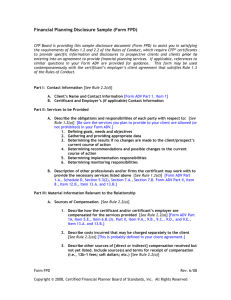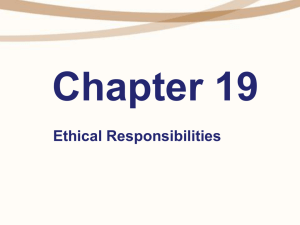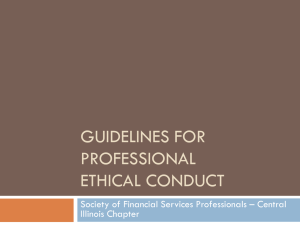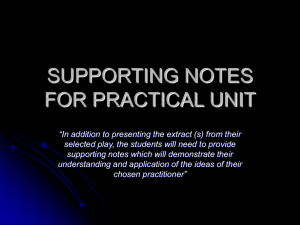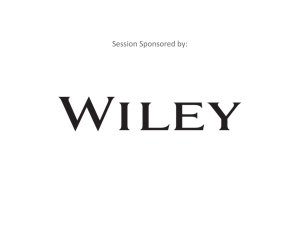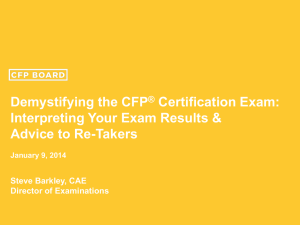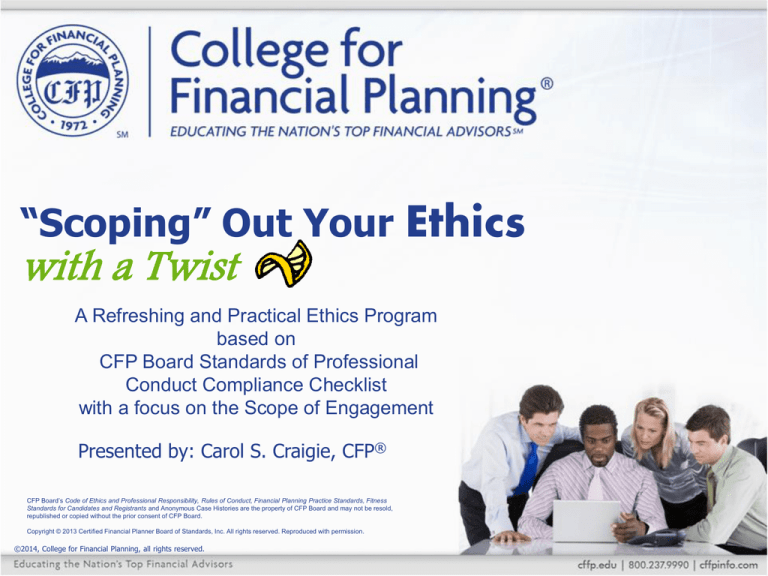
“Scoping” Out Your Ethics
with a Twist
A Refreshing and Practical Ethics Program
based on
CFP Board Standards of Professional
Conduct Compliance Checklist
with a focus on the Scope of Engagement
Presented by: Carol S. Craigie, CFP®
CFP Board’s Code of Ethics and Professional Responsibility, Rules of Conduct, Financial Planning Practice Standards, Fitness
Standards for Candidates and Registrants and Anonymous Case Histories are the property of CFP Board and may not be resold,
republished or copied without the prior consent of CFP Board.
Copyright © 2013 Certified Financial Planner Board of Standards, Inc. All rights reserved. Reproduced with permission.
©2014, College for Financial Planning, all rights reserved.
Ethics Course Learning Objectives
• Define elements of the fiduciary standard.
• Determine when the fiduciary standard applies in a
variety of financial planning contexts and scenarios.
• Determine if a CFP® professional is providing financial
planning services or material elements of financial
planning services.
• Explain CFP Board's compensation disclosure
•
requirements to clients and prospective clients
Communicate any potential conflicts of interest to a client
at the initiation of client engagement AND at
recommendation.
2
Two-Hour Ethics Education
In this class we will:
• Examine the Standards of Professional Conduct
Compliance Checklist with emphasis on
disclosures and timing.
• Review CFP Board case studies.
• Review sample Scopes of Engagement and
complete peer reviews.
• Discuss additional disclosure requirements
during planning process.
• Examine the behavioral economic concepts that
apply.
3
CFP Board Fiduciary Standard
This definition of fiduciary applies when a CFP ®
Professional or Professional Eligible for Reinstatement is
engaged in FP or material elements of FP.
“One who acts in utmost
good faith, in a manner he
or she reasonably believes
to be in the best interest of
the client.”
When not engaged in FP , a baseline standards of care as
outlined in Rules of Conduct 1.4 applies. (refer to checklist)
4
What’s wrong with this picture?
Some actions that caused inquiries:
• Did not disclose to the client that Respondent was
only authorized to sell long-term care insurance
policies for one company. Case 21547, Private
Censure, Suitability, Conflict of Interest, Disclosure to
Clients
• Performed financial planning services for a client’s
(“Client”) father (“Client’s Father”) without
providing to the Client’s Father a written financial
planning agreement and written disclosures and
when he received the Client’s Father’s funds
through a bank account controlled by Respondent.
Case 19075, Revocation, Fiduciary Duty, Disclosures,
Diligence, Suitability, Client’s best interest
5
What is violated here?
• Failed to clarify his lack of involvement in
recommending and endorsing a particular
investment to his clients. Case 15982, Private Censure,
Diligence, Disclosure to Clients, Professionalism
• Failed to: (1) communicate with Husband and
Wife appropriately regarding conflicts with
representing both after he became aware of their
potential divorce; and (2) appropriately respond
to Wife’s inquiries and subsequent check
processing by failing to inform her that Husband
refused to consent to the sale of investments to
cover a large check. Case 24706, Private Censure, Conflict of
Interest, Disclosure, Client’s best interest, Diligence
6
What’s wrong here?
• Did not notify a client (“Client”) that he would
•
not be preparing her tax returns, and did not
follow up with the Client regarding her tax
returns. Case 20942, Private Censure, Professionalism
Did not inform the Client that she had
unrealistic investment expectations. Case 16836,
Private Censure, Dilligence, Professionalism
• Did not perform a cash flow analysis regarding
his client’s ability to pay the premiums for the
insurance policies recommended. Case 23352,
suspension, fiduciary duty, suitability
• Failed to disclose outside business activities to
his employer. Case 25939, Private Censure,
Professionalism, Professional Discipline
7
Practical Application – Document this!
8
Twist: Exploring the Behavioral
Economics of Ethics
• The study of social, cognitive, and emotional
•
factors in understanding the economic
decisions of individuals, and
How implementing the steps in the compliance
checklist makes it easier for
clients to act
9
Read Section A
10
“Is You Is or Is You Ain’t” Delivering
A Financial Plan?
Actions and documentation depend on
how this is answered!
In both cases, you must
make disclosures…
the difference is:
“Are they in written
contract form?”
Let’s examine
the rules.
11
Material Elements of a
Financial Planning Engagement
CFP Board considers the circumstances involved,
including:
• the client’s understanding and
•
•
•
intent in engaging the CFP®
professional,
the degree to which multiple
financial planning subject
areas are involved,
the comprehensiveness of
data gathering, and
the breadth and depth of
recommendations.
12
Not Considered Financial Planning
by CFP Board
•
•
•
•
•
•
•
Opening an account or completing an application
Fact-finding to meet regulatory requirements for suitability
such as “Know Your Customer” rules
Solely providing brokerage and/or insurance products or
services
Engaging in an activity solely related to the sale of a specific
product
Acting as a mortgage broker without
providing any other financial services
Completing tax returns without
providing any other financial services
Teaching a financial class or
continuing education program
13
What does this change?
• You automatically ask for tax returns,
•
beneficiary designations, and investment
statements. Your intention is to just open up an
investment account.
Halfway through your process, you realize the
client has a more complex tax situation and
estate issues than you thought and you are
concerned about how you are titling the
investment account.
If you change from a non-planning engagement to a planning engagement,
you must create a scope of engagement document and have the client sign!
14
Practice Standard 100-1: Defining
the Scope of the Engagement
Page 1, Section A: Rule 1.1: *The certificant and the prospective client or
client shall mutually agree upon the services to be provided by the certificant.
1
2
3
*(CFP Board’s Standards of Professional Conduct, Certified Financial Planner Board of Standards Inc., 2009)
15
Rule 1.2: Written Agreement
*If the certificant’s services include financial planning or material elements of financial planning, prior to entering
into an agreement, the certificant shall provide written information or discuss with the prospective
client or client the following:
a. The obligations and responsibilities of each party under the agreement.
b. Compensation that any party to the agreement or any legal affiliate to a party to the
agreement will
or could receive under the terms of the agreement.
c.
Terms under which the agreement permits the certificant to offer proprietary products.
d.
Terms under which the certificant will use other entities to meet any of the agreement’s
obligations.
If the certificant provides the above information in writing, the certificant shall encourage the
prospective client or client to review the information and offer to answer any questions that
the prospective client or client may have.
Does your scope of engagement
meet this requirement?
*(CFP Board’s Standards of Professional Conduct, Certified Financial Planner Board of Standards Inc., 2009)
16
Rule 1.3: What the Agreement
Specifies
*If the services include financial planning or material elements of financial
planning, the certificant or the certificant’s employer shall enter into a written
agreement governing the financial planning services. The Agreement shall
specify:
a. The parties to the Agreement,
b. The date of the Agreement and its duration,
c. How and on what terms each party can terminate the Agreement,
and
d. The services to be provided as part of the Agreement.
The Agreement may consist of multiple written documents.
Form ADV or other disclosure documents, shall
satisfy the requirements of this Rule.
*(CFP Board’s Standards of Professional Conduct, Certified Financial Planner Board of Standards Inc., 2009)
17
Why a scope of engagement?
• What’s your goal for scope of engagement?
“This describes what I have
committed to doing as a CFP ®
professional when I work for you.”
“I would like to review this with
you to make sure we are on the
same page and you have all the
facts you need to make an informed
decision about hiring me.”
18
Disclosures: Excuse or Use
• Distrust is triggered when you say, “here’s the zillion
•
pages our lawyers make us use. I need you to sign it.”
Trust is triggered when you say, “It’s really important
that you understand where conflicts of interest may
arise and how I get paid so you can make informed
decisions. Let’s go through this document together to
make sure it’s clear in case there are legal or financial
terms with which you may not be familiar.”
A tale of 2 salespeople:
Which do you trust?
19
Behavioral Economics and
Disclosures (ADV & Other)
• Distrust of financial companies is at an all-time high in
the United States; finance is now in the lowest three
trusted industries.*
• When distrust is triggered, it makes people doubt even
simple statements like the sky is blue or the sun is
yellow.
• Distrust is triggered by unmet expectations,
miscommunication, lack of information, and feeling
“sold.”
• Disclosures can disarm distrust.
*2012 Edelman Trust Barometer Findings
20
Required Elements
•
•
•
•
•
•
•
•
•
•
Clearly identifies WHO the agreement is with (parties of the
agreement)
Clearly identifies what services the client will receive
Clearly identifies what services the client will NOT receive
Clearly identifies the process the client should expect
Clearly identifies what we expect from clients in the process
Clearly identifies starting date and when the contract ends
Clearly identifies now and what terms a party can terminate
agreement
Clearly discloses conflicts of interest
Clearly identifies offering of proprietary products
Clearly defines when other entities will meet obligations
21
Sample Scope of Engagement
CFP Board sample includes:
• types of services,
• length of engagement and how it’s determined,
• fee for services and when it is due,
• what compensation is received from other
sources,
• expectations of client,
• conflicts of interest, and
• fiduciary standard statement.
22
Behavioral Economics and Scope of
Engagement
• Use Expectations Impact and Priming
to help clients have the right expectations.
• Scope of engagement is
setting expectations and
priming clients.
What is your message?
23
CFP Board’s Services Descriptions
Here are some sample descriptions:
• Developing a summary of your current financial situation, including a net worth
•
•
statement, cash flow summary, and insurance analysis. 1. Includes P&C?
1
2
Reviewing your current investment portfolio and developing an asset
management strategy.
2. Includes 401(k)/real estate advice?
3
Developing a financial management strategy, including financial projections and
analysis.
3. Business cash flow projection, detailed
budgeting, how many years?
How clear is your description?
Would most clients understand?
24
Scope of Engagement: Priming
Client Responsibilities
Intention is the same and the message is similar,
but priming is different.
25
Priming and Expectations Impact
What is this scope of engagement priming?
Good compliance, good ethics, and good business
26
Practical Steps: Review Your Scope
of Engagement
• Does it meet all the requirements?
• What is being primed?
• What expectations will clients have and can you
•
•
consistently meet them?
Is the process clearly defined so clients know
their role? Is it an active or passive role?
Does the process you are explaining match your
business requirements for timing, ability to
deliver, etc.?
27
Now let’s examine….
There are sample scopes of engagements available
on the tables.
You were asked to bring three copies of your form
to share.
Use the form and trade scopes of engagement and
give feedback using the Assessment form.
If no one brought theirs, please use the ones on
the table.
28
Tips for Effective Agreements
• Use easy to understand and specific language so you and
•
•
•
•
clients know what you are offering.
Incorporate a benefit statement.
Test it with non-planners/non-clients using confirmation
skills.
Ask your clients to evaluate its clarity, benefits, and
whether it accurately reflects what you deliver.
Put it in a form where clients can initial the services they
want.
What benefit do you think you will receive from this process?
What benefits will clients receive?
29
Sharing
30
Break
31
How Do You Determine the Client’s
Understanding and Intent?
1
• Giving the client information is not enough to
•
•
understand their understanding.
These questions don’t work:
o Do you understand?
o Is that clear?
o Do you agree?
These are the types of questions
that may get you the bobble head!
32
Avoid the Bobble Head
Use Confirmation Skills to Get the Client to Talk!
• “Just to make sure we are on the same page, tell me
what you are expecting from this planning experience.”
• “It’s easy to interpret words differently, so please help
me out and tell me what you think this says.”
• “Now that you’ve read the scope of engagement, can
you tell me what you think will be most beneficial for
you? Can you tell me any services that aren’t mentioned
that you expected or were hoping were included?”
Document this: Write down their answer with their words
Behavioral Twist: The act of writing conveys the message that
what they say is important!
33
Behavioral Economics, Contracts,
and Disclosures
• Both advisors and clients have an Illusion of
Transparency, so we have to work hard at clear
understanding and demonstrating trustworthiness.
• Avoid Confirmation Bias by using confirmation skills.
34
Sec. B 1-3
35
Implementation Rules
Rule 2.1: A certificant shall not communicate, directly or
indirectly, to clients or prospective clients any false or
misleading information directly or indirectly related to the
certificant’s professional qualifications or services.
A certificant shall not mislead any parties about the
potential benefits of the certificant’s service.
A certificant shall not fail to disclose or otherwise omit
facts where that disclosure is necessary to avoid
misleading clients.
Rule 4.5: In addition to the requirements of Rule 1.4, a
certificant shall make and/or implement only
recommendations that are suitable for the client.
36
Next Critical Disclosure
• What products and services need additional
disclosure?
37
Sample Implementation Documentation
1. Separate the issue of who is
providing a product from whether
it’s a good idea.
2. Ask for decision of:
YES NO DEFER EXPLORE
3. Initially, married couples don’t
have to agree … get each opinion
and finalize later.
4. Keep brief, but give enough
details and benefits, if possible,
with longer explanations in
recommendations.
5. Define who, what, when, and
where under action items and
target date.
6. This becomes the roadmap for
you and client.
38
Practice Standard 500-1: Agreeing on
Implementation Responsibilities
*The financial planning practitioner and the client shall mutually agree on the implementation responsibilities
consistent with the scope of the engagement.
The client is responsible for accepting or rejecting recommendations and for retaining and/or delegating
implementation responsibilities. The financial planning practitioner and the client shall mutually agree on the
services, if any, to be provided by the practitioner. The scope of the engagement, as originally defined , may
need to be modified. The practitioner’s responsibilities may include, but are not limited to the following:
• Identifying activities necessary for implementation;
• Determining division of activities between the practitioner and the client;
• Referring to other professionals;
• Coordinating with other professionals;
• Sharing of information as authorized; and
• Selecting and securing products and/or services.
If there are conflicts of interest, sources of compensation or material relationships with
other professionals or advisers that have not been previously disclosed, such conflicts,
sources or relationships shall be disclosed at this time.
When referring the client to other professionals or advisers, the financial planning practitioner shall indicate the
basis on which the practitioner believes the other professional or adviser may be qualified.
If the practitioner is engaged by the client to provide only implementation activities, the scope of the
engagement shall be mutually defined in accordance with Practice Standard 100-1. This scope may include such
matters as the extent to which the practitioner will rely on information, analysis or recommendations provided
by others.
*(CFP Board’s Standards of Professional Conduct, Certified Financial Planner Board of Standards Inc., 2009)
39
Practice Standard 500-2: Selecting
Products and Services
*The financial planning practitioner shall select appropriate products and
services that are consistent with the client’s goals, needs and priorities.
The financial planning practitioner shall investigate products or services that
reasonably address the client’s needs.
The products or services selected to implement the recommendation(s) must
be suitable to the client’s financial situation and consistent with the client’s
goals, needs and priorities.
The financial planning practitioner uses professional judgment in selecting the
products and services that are in the client’s interest. Professional judgment
incorporates both qualitative and quantitative information.
Products and services selected by the practitioner may differ from those of
other practitioners or advisers. More than one product or service may exist that
can reasonably meet the client’s goals, needs and priorities.
The practitioner shall make all disclosures required by applicable regulations.
*(CFP Board’s Standards of Professional Conduct, Certified Financial Planner Board of Standards Inc., 2009)
40
Practice Standard 600-1: Defining
Monitoring Responsibilities
*The financial planning practitioner and client shall mutually define monitoring
responsibilities.
The purpose of this Practice Standard is to clarify the role, if any, of the practitioner in the
monitoring process. By clarifying this responsibility, the client’s expectations are more
likely to be in alignment with the level of monitoring services which the practitioner intends
to provide.
If engaged for monitoring services, the practitioner shall make a reasonable effort to define
and communicate to the client those monitoring activities the practitioner is able and willing
to provide. By explaining what is to be monitored, the frequency of monitoring and the
communication method, the client is more likely to understand the monitoring service to be
provided by the practitioner.
The monitoring process may reveal the need to reinitiate steps of the financial planning
process.
The current scope of the engagement may need to be modified.
*(CFP Board’s Standards of Professional Conduct, Certified Financial Planner Board of Standards Inc., 2009)
41
Behavioral Economics and Monitoring
• Painting the picture of our future together starts a
whole new set of priming and expectations.
• Lack of vision of future together creates distrust.
• Feelings of bait and switch if your actions don’t match
the vision and expectations.
• Lack of communication (even when you’ve nothing to
say) is the biggest cause for clients leaving.
• Financial planning is a trend line. The longer the time
between updates, the more your projections will be off,
creating distrust.
42
Rule 2.2 always applies:
*A certificant shall disclose to a prospective client or client the following information:
a. An accurate and understandable description of the compensation arrangements being
offered. This description must include:
i. Information related to costs and compensation to the certificant and/or the
certificant’s employer, and
ii. Terms under which the certificant and/or the certificant’s employer may receive
any other sources of compensation, and if so, what the sources of these
payments are and on what they are based.
b. A general summary of likely conflicts of interest between the client and the certificant,
the certificant’s employer or any affiliates or third parties, including, but not limited
to, information about any familial, contractual or agency relationship of the
certificant or the certificant’s employer that has a potential to materially affect the
relationship.
c. Any information about the certificant or the certificant’s employer that could
reasonably be expected to materially affect the client’s decision to engage the
certificant that the client might reasonably want to know in establishing the scope
and nature of the relationship, including but not limited to information about the
certificant’s areas of expertise.
d. Contact information for the certificant and, if applicable, the certificant’s employer.
*(CFP Board’s Standards of Professional Conduct, Certified Financial Planner Board of Standards Inc., 2009)
43
Back to the case studies…
Did not disclose to the client that Respondent
was only authorized to sell long-term care
insurance policies for one company. Case 21547,
Private Censure, Suitability, Conflict of Interest,
Disclosure to Clients
Failed to clarify his lack of involvement in recommending
and endorsing a particular investment to his clients. Case
15982, Private Censure, Diligence, Disclosure to Clients, Professionalism
Rule 2.2 Violations – whether it’s a plan or not!
44
If No, There Are More Steps Beyond
Disclosures
Rule 3.3: *A certificant shall obtain the information necessary to fulfill his or
her obligations. If a certificant cannot obtain the necessary information, the
certificant shall inform the prospective client or client of any and all material
deficiencies.
*(CFP Board’s Standards of Professional Conduct, Certified Financial Planner
Board of Standards, Inc., 2009)
45
Section 3: When Not a Financial Plan
Baseline standard of care applies –outlined in
rules of conduct 1.4!
Rules 2.2 and 4.5 still apply!
46
See How It’s Different
Non Planning Engagement
Some of the same rules, but note that some documentation requirements are
removed. Question is: How do you document you completed the requirement?
Planning Engagement
47
CFP Board Really Has Made It
Easier To Comply!
Use the four-page form
and include documentation
for every client.
It’s good ethics.
It’s good compliance.
It’s good business.
48
Summary: Frequently Asked Questions
49
Thank you!
And all the best to you in your practice!
For 3rd insurance hour please re-sign
in!
50
Resources
1.
2.
3.
CFP Board’s Standards of Professional Conduct, Certified Financial Planner Board of Standards Inc., 2009.
4.
Leonard, L., Frederick, S., and Ariely, D. “Try It, You'll Like It: The Influence of Expectation, Consumption, and
Revelation on Preferences for Beer.” Psychological Science. December 2006 17: 1054-1058.
5.
Shih, M., Pittinsky, T. L., and Ambady, N. “Stereotype Susceptibility: Identity Salience and Shifts in Quantitative
Performance.” Psychological Science , Vol. 10, No. 1 (Jan. 1999), 80-83. Published by: Sage Publications, Inc. on
behalf of the Association for Psychological Science Article Stable URL: http://www.jstor.org/stable/40063382
6.
Gilovich, T., and Savitsky, K. “The Spotlight Effect and the Illusion of Transparency: Egocentric Assessments of How
We Are Seen by Others.” Current Directions in Psychological Science , Vol. 8, No. 6 (Dec., 1999), pp. 165-168
Published by: Sage Publications, Inc. on behalf of Association for Psychological Science Article Stable URL:
http://www.jstor.org/stable/20182597
7.
8.
Pompian, M. M. (2012). Behavioral Finance and Wealth Management. Hoboken: Wiley Finance. 73-84
9.
10.
11.
12.
13.
Ariely, D. (2010). The Upside of Irrationality. New York: HarperCollins, 109-116
Listening skills reference
Chang, J. (2011). A case study of the “’Pygmalion Effect’: Teacher expectations and student achievement.”
International Education Studies, 4(1), 198-201.
Stephen. (2010, Jan 12). Set a goal and score in the future. Timaru Herald. Retrieved from
http://search.proquest.com/docview/313902670?accountid=35812
Khaneman, D., and Tversky, A. (1984). "Choices, values, and frames." American Psychologist 39 (4): 341–350.
Airely, D. (2008). Predictably Irrational. New York: HarperCollins.
Snow, A. (2010) Journal of Risk and Uncertainty 40. 2 (Apr. 2010): 133-145.
Ariely, D. (2010). The Upside of Irrationality. New York: HarperCollins, 32-33
51
Scoping out your Insurance Ethics too!
Presented by:
Associate Professor
Carol S. Craigie, ChFC, CFP®
©2014, College for Financial Planning, all rights reserved.
52
This Next hour…
• Explore Fiduciary Duty and reasons to adopt
• Research on client satisfaction, stickiness and
ethics
• Explore cases of violation including insurance
issues through CFP Board Anonymous Case
Studies
Different definitions
• Same concept/different standards
• Lines are blurry but client expectations are not!
54
Case Study 1 - #19812
The wife of a former client (“Client”) lost her claim
for benefits due to an inaccurate answer on the
Client’s life insurance application.
Violation of state Consumer Protection Act
Diligence, Negligence, Misrepresentation, Breach of
Contract, Fiduciary Duty
55
Case Study 2 - #23352
Failed to: 1) perform an investigation and analysis
into the insurance needs of his clients prior to
recommending that they purchase insurance
policies; 2) perform a cash flow analysis regarding
his client’s ability to pay the premiums for the
insurance policies recommended by Respondent;
and 3) present his insurance recommendations
and ensure that the recommendations met his
client’s expectations with respect to their ability to
“premium offset” in five years.
Client’s best interest, Suitability, Fiduciary Duty
56
Case Study 3 - #21319
Conducted unregistered financial planning
seminars about insurance products without
identifying himself as an insurance producer,
offered inducements to purchase financial planning
services and conducted business in an
unregistered branch office.
Misrepresentation, Failure to Register, Professionalism
57
Case Study 4 - 21725
Recommended and sold a viatical to the Client,
who was 85 years old at the time, when
Respondent was not licensed to do so
Failure to Register, Professionalism, Client’s Best Interest
58
Case Study 5 - #13449
Recommended clients over-concentrate their assets in
annuities; 2) failed to adequately supervise while serving
as both a broker-dealer principal and compliance officer of
a broker-dealer in twenty-two states with fifty brokers and
five registered investment advisors
Professional Discipline, Professionalism, Suitability,
Lawsuits involving Financial Matters
59
Case Study 6 - #18861
Inaccurately completed a health insurance
application for a client (“Client”), leading to
rescission of the Client’s coverage and
Respondent’s violation of a state statutory
provision.
Settlement, Professional Discipline, Professionalism,
Misrepresentation, Diligence
60
Case Study 7 - #22820
When he promised to personally make the client
whole after the client sustained alleged losses on a
free withdrawal from an annuity.
Professionalism, fitness
61
Case Study 8 - #23777
Recommendation resulted in 70% of the clients’
assets being invested in annuities.
Professionalism, Suitability, Fitness, Customer Complaints,
Professional Discipline
62
Case Study 9 - #19834
Obtained waivers of Contingent Deferred Sales
Charges (“CDSCs”) for approximately 14 customers
by claiming that these customers were disabled,
when, in fact, they were not.
Employer Policy violation, Misrepresentation,
Professionalism, Professional Discipline, Diligence, Fraud
related to Professional Activity
63
In summary
Good Ethics
=
Good Business
64
CFP Board Standards of Professional Conduct
End of Slides
©2014, College for Financial Planning, all rights reserved.

